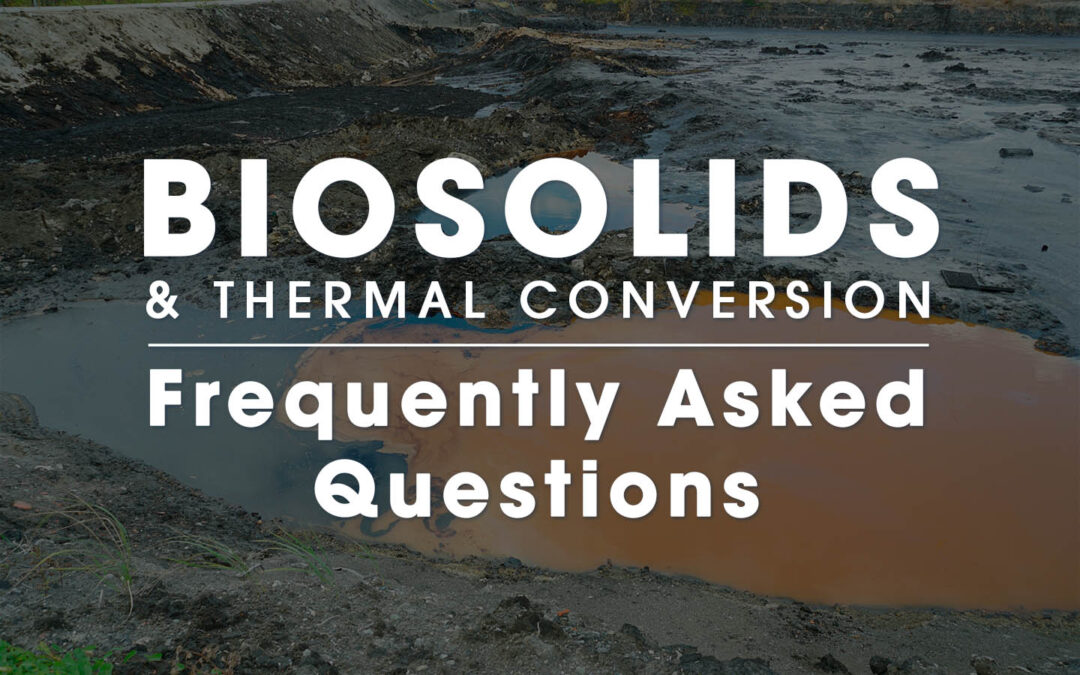Updated May 29, 2024.
What are biosolids?
Biosolids are the dried residual sludge created by treating municipal wastewater.
What are the main contaminants in biosolids?
Heavy metals, micro plastics, pharmaceuticals, and so called forever chemicals that never break down.
What is the thermal conversion process and how does it work?
Applications of high temperatures to biosolids in the absence of oxygen (air), which convert them into biochar and fossil fuel free energy (a fuel gas).
What is biochar and how can it be used?
Biochar is a sterilized substance made up of carbon, which contains the nutrients and minerals in biosolids, but not the complex contaminants of concern. It can be used as a soil supplement and safely in several industrial processes.
How does thermal conversion differ from incineration?
Thermal conversion is not incineration. Incineration requires large volumes of air in its burning process and releases large volumes of toxic gases. Thermal conversion uses only tiny amounts of air and does not produce toxic gases.
What happens to the contaminants in the thermal conversion process?
They are destroyed in the high temperature heating process.
What happens to heavy metals in the thermal conversion process?
They are retained in the biochar. The biochar can be used in soil if it meets stringent regulatory standards. At higher concentrations, it can be used safely in industrial processes.
What gas is produced by thermal conversion and how can it be used?
A synthetic gas or syngas made up of hydrogen, carbon monoxide, volatile organic compounds and carbon dioxide, which can be used for heat energy. It is fossil fuel free and therefore renewable energy.
How big is the market for biochar?
There is a growing market for biochar in the order of $230 million in North America growing at a rate of 12% annually.
Can thermal conversion capture carbon?
Yes, the biochar contains the carbon in the waste stream, which is sequestered forever so it reduces carbon emissions to the atmosphere.
What is Integrated Resource Management and how does it work?
Integrated Resource Management is a waste resource recycling & recovery process which balances financial returns, pollution control and protects public health to achieve the best community valued outcomes.
Who regulates the thermal conversion plant?
The Provincial Ministry of Environment and Climate Change.
Where is the thermal technology already in operation?
There are over 500 operating plants in Europe and Asia using municipal and industrial wastes starting from the mid 1980s.
What is the life expectancy of a thermal conversion plant?
They are made of steel and typically built for a period of at least 30 years.
Can other sources than biosolids be subject to thermal conversion?
Potentially yes. Municipal solid waste—garbage—can be shredded, dried and thermally converted into biochar as can organic waste such as kitchen scraps and yard and garden waste. Components of construction and demolition waste such a wood and carpets can also be thermally converted.
Are there any downsides to thermal conversion?
Not really, especially when compared to the alternative of applying biosolids on land. However although it is proven technology, there are few operating plants in North America and so it will be a new experience for local municipalities to implement them.
Are there legal liabilities to land application of biosolids?
There are a growing number of cases where the application of biosolids on land has led to legal challenges due to impacts on human health and the environmental. For example, Synagro, which operates the CRD’s biosolids program is facing a lawsuit for poisoning livestock and polluting drinking water in Texas. Also, the Environmental Law Centre at the University of Victoria advised CRD in 2013 of the potential for litigation should land application ever be shown to be detrimental to human health and the environment.
What Countries ban land application of biosolids?
A number of European countries and the State of Maine ban land application of biosolids because of its toxicity. The CRD is the only Regional District in British Columbia that currently bans land application because of its toxicity other than at Hartland , which is permitted on an emergency basis till thermal destruction options are available.
What technologies are best suited to destroy biosolids once and for all?
To start with, producing Class B or Class A biosolids is a biological process and little heat is used to maintain the correct temperature so the mesothermic bacteria can function efficiently (around 35-40 degrees C). This is what is happening now at the CRD’s Residuals Treatment Facility and, most importantly, this process does not destroy the toxic and harmful chemicals found in sewage sludge – they remain in the biosolids and would be applied to the land.
Incineration which does destroy all of the carbonic material and toxic chemicals, unfortunately also produces very large volumes of air emissions which contain pollutants. We are not recommending incineration for biosolids disposal because of the potential for air pollution. Also, incinerators are usually large facilities and are simply not suitable economically for only 10 tonnes of biosolids per day!
The technologies we support are called ‘thermal conversion’ systems and include pyrolysis and gasification systems. There are several types of pyrolysis and gasification systems but importantly they are the only truly thermal conversion technologies because at a high temperature, and importantly without air, they breakdown and convert the solid biosolids into simple fuel gases (like hydrogen and carbon monoxide) which can then be burned very efficiently in a secondary process under strictly controlled conditions and thereby eliminate pollution. The thermal conversion technologies also pull apart and convert the toxic compounds (including “forever chemicals”) into useful fuel gases (hydrogen, carbon monoxide) as well.
